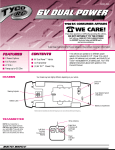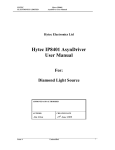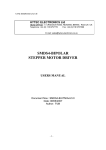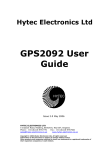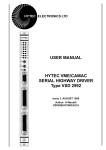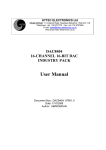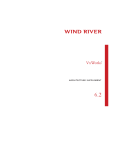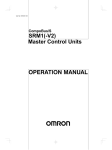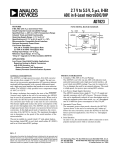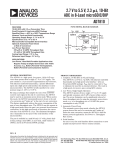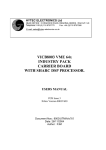Download Hytec Electronics Ltd – VME64x `Hot Swap` Functionality Support
Transcript
Hytec Electronics Ltd – VME64x ‘Hot Swap’ Functionality Support • • • • • • Fully VME64x (i.e. VITA 1.1-1998 VME64 Extensions Standard) compliant. Allows Carrier Card Replacement without the need to power down its IOC. Allows Any IP Replacement without the need to power down its IOC. Completely Safe – all hardware is design protected hot swap safe. Hytec Electronics Ltd provided drivers will automatically re-instate the new hardware. No need for new code development from the end user. Provides High System Availability and Increased System Uptime. HYTEC Head Office HYTEC Leicester Office Post : 5 Cradock Road, Reading, Berkshire, RG2 0JT, England. Phone : +44 (0)118 9757770 Fax : +44 (0)118 9757566 Post : 64 Amy Street, Leicester, LE3 2FB, England. Phone : +44 (0)116 2630250 Fax : +44 (0)116 2630399 Email : [email protected] 1 Introduction In this document, we discuss Hytec Electronics hardware implementation and software, involved in supporting hot swap in Industry Pack (IP) card drivers on VME64x carrier cards such as the Hytec8002. By hot swap, we mean the ability to simply unplug a VME64x IP carrier card from a correctly configured and running Input/Output Controller (IOC), replace a defective component, say one of the IP cards, on the board and replace it into the running system. The system will recognise that a board has been removed and replaced and resume normal operation. Hot swap capability can be very useful in increasing overall system uptime, especially in large installations. 2 Definitions and Glossary of Terms Term Description DIN-style Connector VME board and backplane connectors, as described in IEC 60603-2 and IEC61076-4113. A connection from the chassis to the building’s grounding system. This ground is usually isolated from logic ground in the chassis. Mechanical Levers mounted at the ends of a VME Board faceplate / front panel which allow easy extraction and removal from a sub rack without the need for any tool. These levers are fully specified in Chapter 8 of the IEEE 1101.10-1996 Standard. Optional sensing versions are available which indicate when a board is correctly seated and the levers locked. Input/Output Controller. Industry Pack. The ability to insert or withdraw boards while the system is powered and operating without interruption of the system operation or damage to the system. A VME64x board connector pin which contacts with the backplane connector before any of the VME64x signal pins. These early contacts provide a pre bias voltage or Pre-Charge Voltage (VPC) Pre-Charge Voltage (VPC) a supply voltage which attaches before and is removed after the main supplies and VME bus pins. Boards and/or sub rack components compliant with VITA 1.1-1998 VME64 Extensions Standard. Frame Ground Injector / Extractor IOC IP Live Insertion Pre-leading pin VPC VME64x compliant 3 Card Hardware to Allow Hot Swap Support In brief Hytec Electronics Ltd carrier cards (for instance the Hytec8002) have the following hardware features in support of their hot swap VME64x compliance. 3.1 Extra Connectors and Transition Boards The VME64x standard provides for additional pins and connectors which allow all external connections to be made via a transition board. This allows all external wiring to be made to the rear of the IOC. Therefore there is nothing to disconnect and nothing to inhibit easy carrier card replacement. 3.2 Pre-Charge Voltage (VPC) Certain ground and supply pins (known as Pre-leading Pins) on the VME64x connectors are longer than the rest, allowing them to connect earlier during insertion. This early voltage supply, specifically known as the Pre-Charge Voltage or VPC, is used as a power up the carrier card’s Hot Swap Voltage Controller and VME Bus buffer ICs. The Hytec Electronics Ltd carrier cards use a Summit Hot Swap Controller and dual supply buffers. These dual supply buffers on detection of VPC drive the VME bus to the safe tri-state condition before it is actually connected. The hot swap controller awaits the LI/I signal from the VME back plane then run the powers up sequence, generate an on-board reset and then finally release the tri-state on the VME bus buffers. The VPC longevity is used in a reverse manner when removing a carrier card. 3.3 Locking Injector / Extractor Position Sensing Handle VME64 has always used special carrier card handles which allow easy, reliable extraction and insertion without the need for any additional tools. The Hytec Electronics Ltd range of VME64x carrier cards are equipped with sensing injector/Extractor Handles. They provide a low level (ground) when the card is correctly seated and the ejector locked in, and a high (pull up from VPC) as soon as the ejector is unlocked. The Summit Hot Swap Controller can directly accept these signals and responds to them in a similar way to a VPC removal or detection. This gives an extra level of warning and protection to the hot swap hardware and applications. This is an option of VME64x compliance, which Hytec Electronics Ltd fits as standard for the extra reliability and safety of its hot swap range. 3.4 Electro-Static Discharge The Hytec Electronics Ltd range of VME64x carrier cards are designed to support safe electrostatic discharge via two sources… 1. The carrier cards have a bottom PCB edge is exposed metal (known as a ‘printed wiring strip’). 2. The carrier card front panel has guide pins both top and bottom to provide additional discharge sources through the guide pin sockets in the IOC. The carrier cards are fitted with 2.2 MegOhms discharge resistors to provide safe discharge paths via any of the above drain sources. This safely discharges the carrier card during any hot swap. 3.5 Front Panel Display VME64x compliance demands certain Front Panel LEDs and defined operation. Hytec Electronics Ltd range of carrier cards fully supports this with its ‘VME’ green LED and ‘NOT CONFIGURED’ blue LED. 4 Software Basic concepts and restrictions Assuming that the hardware is hot swappable, i.e. it adheres to the VME64x standard (at least for the most part, see section XX for slight deviations from the standard that can be accommodated in software). Note that only the carrier card, but not the IP card hardware, need conform to the standard. If the IP driver software is correctly written, any IP card will be hot swappable if it is mounted on a hot swappable carrier card such as the Hytec 8002 carrier card. In general, the modified drvIpac software supports scheduled and unscheduled hot swap events. In scheduled hot swap, the user calls the routine ipacHSRemove before physically removing the carrier card from the VME system. This allows the drivers to shut down the hardware before the board is removed. This can allow the hardware to bring itself into a state which suitable for swapping out. In unscheduled hot swap, the card is simply removed without any warning to the software system. If boards are to be removed from and inserted into a running system at any time, this is possible and supported by Hytec Drivers and Hardware but poses some problems for the software (see restrictions below). In this document, we restrict ourselves to the case where we want to replace a faulty piece of equipment in a running system. We therefore assume that: Every VME slot must have a carrier board with functionally the same hardware before and after the swap. This restriction still ALLOWS the following swaps… 1. The replacement of a faulty IP card with a functional equivalent. 2. The replacement of a faulty carrier card. 3. Multiple carrier cards can be removed from the system at any given point in time. It is legitimate to remove two or more carrier cards, replace any number of IP cards with functional equivalents on the removed carriers, and then to replace the carriers into the identical VME slots. This restriction DISALLOWS the following swaps… 1. Moving of a carrier card from a VME slot n to m. 2. Adding an IP card to an empty IP slot on a carrier. 3. Adding a new VME64x carrier card to the system. If any of these operations need to be performed, then the system will need to be reconfigured, which typically requires at least a reboot of the IOC. 5 Software Design 5.1 Overview There are two essential elements to supporting hot swap in software… • • First, a removal and reinsertion event has to be recognised. Secondly, the software must know how to react when these events occur. Carrier status flag XXX YY Y Broad Presence (1=Removed) Removal Insertion Fig 5.1 Board Removal / Insertion Timings Fig 5.1: approximate time-state diagram of a carrier card removal and reinsertion event. There is a time delay when using polling to determine removal and reinsertion events, marked as XXX for removal and YYY for reinsertion. The delay marked XXX can affect system integrity if a driver attempts to access a carrier after it has been removed, but before this has been detected by the carrier polling task. 5.2 Detecting Card Removal There are two techniques for detecting the removal of a carrier card. 5.2.1 Interrupt According to the VME64x specifications, a carrier should generate an interrupt when the card is withdrawn. When the handles of the carrier card have been flipped up, but before the card can be removed completely from the crate, the card will generate an interrupt. The VME64x specifications furthermore state that the VME slot number should be put on the bus by the card. In this way, the processor can quickly determine when which card is being removed. Often IP cards on the carrier will generate their own interrupts for their own functionality. It is necessary for the carrier to have its own interrupt vector to handle the removal event. It is advisable to choose a higher priority for the card removal interrupt level than for the IP interrupt levels. In this scenario, the card removal interrupt service routine (ISR) sets a flag for the presence of each carrier card. The IP driver routines check the status of this flag before accessing the hardware in the usual way. Note that this does not guarantee trouble free operation when removing a carrier card because the checking of the carrier status flag and hardware register access cannot be performed as an atomic operation. For example, a bus error can occur in the following case: The IP driver checks the carrier present flag and finds the card to be present (flag=true). Right after this, the card is removed, generating an interrupt. As a consequence, the high priority interrupt handler sets the carrier flag to false. Once the interrupt handler exits, the IP driver resumes running. If it now accesses the non-existent hardware registers in the normal way (i.e. without using vxMemProbe()), it will terminate with a bus error. While this scenario will be very rare, it cannot be fully excluded. 5.2.2 Poll and Probe If a carrier card does not generate an interrupt on its removal, this event can nevertheless be recognised by periodic polling. This method can be made to work reliably if… 1. The polling task runs at a higher priority than any other task accessing the hardware to be hot swapped. 2. The driver routine accesses the hardware by using vxMemProbe(). Condition 1 ensures that the data flags signalling the absence of a board are not accessed when the polling task is updating them. This is a mutex on the shared "presence flag" data based on task priority. Condition 2 ensures that a bus error will not occur if the hardware is accessed after a card is removed just after periodic polling has found it to be present (see the delay marked with XXX in figure 5.1). 5.3 Detecting Card Insertion The VME64x specification requires reinsertion of a board to be detected by polling. This is best performed by a high priority task at the carrier level. The IP driver level must check the carrier status flag immediately before accessing hardware registers in order to avoid a bus error. The delay in the detection of a reinsertion event is not critical to the correct functioning of the system (see figure 5.1). 5.4 Acting on Card Removal and Reinsertion The IP driver routines should check for the existence of the hardware before accessing hardware registers. A copy of the hardware registers value should be kept in RAM for each hardware device. When the hardware has been removed, the routines should return a status value indicating the fact to the EPICS record level. Upon reinsertion, the driver should reinitialise the hardware Register set from the previously saved values in RAM where this makes sense. 5.5 Discussion Note that, in principle, carrier card polling or interrupt handling is not necessary if the IP driver level uses vxMemprobe() for all hardware access. However, it is more efficient to handle removal and reinsertion events at the carrier board level rather than for each IP card. In addition, it is advantageous in terms of portability for the IP driver to be able to question the carrier for its existence in the system, regardless of how board removal and reinsertion events are detected. For this reason, the drvIpac header file has been extended with a query function ipmCarrierIsPresent(). In addition, IP drivers should access hardware registers using the VxMemProbe() function to avoid bus errors. 6 Acknowledgements Steve Hunt is the man who first wrote hot swappable EPICS drivers. This document is the result of useful discussions with him. Of course, all errors are entirely mine. W Scott and Dave Brownless who developed the majority of the hardware drivers for Hytec Electronics Ltd. Melvyn Newman and Alan Burley who developed the majority of the actual hardware for Hytec Electronics Ltd. 7 Bibliography For much documentation about EPICS, including a list of all EPICS supported hardware, see the EPICS homepage at http://www.aps.anl.gov [1] The EPICS IPAC drvIpac Module was written by Andrew Johnson <[email protected]>. The homepage of this software is http://www.aps.anl.gov/asd/people/anj/ipac [2] The HyTec Electronics 8002 VME64X industry pack carrier board hardware user manual can be downloaded from the Hytec web site: http://www.hytec-electronics.co.uk [3] The HyTec VICB8002 drvIpac driver user manual can be downloaded from the Hytec web site: http://www.hytec-electronics.co.uk [4] VME64x Live Insertion System Requirements VITA 1.4-200x web site: http://www.vita.com [5] Summit Microelectronics Inc S39421 Hot Swap Voltage Controller Datasheet 2004 9.1 1/23/01 web site: http://www.summitmicro.com







